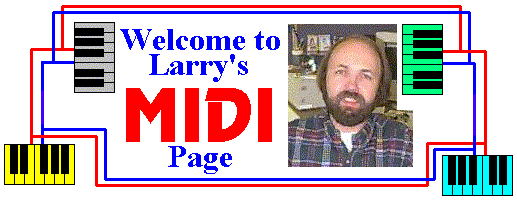

Most sounds cards can also be connected
to a more traditional instrument (most often a keyboard such as Roland,
Kurzweil, Yamaha, Casio, etc) and send and receive MIDI data. For example,
I can play music on a musical keyboard, and all the data about what and
how I am playing (notes, sustain pedal, etc) can be sent to my computer
and captured as MIDI data. Connecting from the instrument to the computer
requires a MIDI interface cable that connects to either
(1) a MIDI/joystick port, or
(2) via a USB port.
In newer computers, the second method is probably your only choice.
Shop around; prices vary. At the minimum, you want one that provides one MIDI-IN and
one MIDI-out. Some of them combine the interface cable with the 5-pin DIN style
MIDI cables that connect to the IN/OUT of your instrument.
Others require that you separately purchase the MIDI cables. See below for the brand I use.
I can edit this on my computer using sequencing software
(which in my case actually shows the notes on the screen as they
are coming in), and then send the data back to the keyboard (as initially
played or as edited) for it to play back (like a player-piano). This alone
enables you to use MIDI with a computer as a "tapeless recording studio".
As you learn to create MIDI sequences with multiple tracks (piano, strings,
percussion, bass, etc), you can develop full arrangements which can be
put on the web, used as background tracks to take into a regular recording
studio, etc. The possibilities are mind-boggling! But even if you're just
a songwriter looking for an easier way to create lead sheets, you will find
MIDI to be a great time-saver.
What is MIDI
In a nutshell, MIDI (Musical Information Digital Interface) is a standard
method of communicating between musical instruments and musical control
devices through a digital connection. Now, sometimes the instrument or
controller is actually a computer! If you have a sound card or integrated
sound, then when you play MIDI sequences (such as the background music on
some web pages), your computer itself is acting as a musical instrument.
A sound card is an add-on to your PC's motherboard, whereas
integrated sound
is built into it already. If you're curious as to which you have, you can always
(carefully) open up your system unit and take a look. Either way is fine --
you get a microphone, line-in, and speaker connections (1/8-inch ports) and,
on older sound cards, a MIDI/joystick port. Generally speaking, however, sound cards
provide superior sound reproduction than integrated.
MIDI Projects
Hear some of my MIDI sequences at
Larry's Songs of Praise and Worship.
One of the projects is a complete children's musical
(entitled "God Cares For You") in which the entire
intrumental background was prepared as MIDI sequences (with every note
clicked into the sequencing software, by the way).
You'll find musical scores prepared with MakeMusic's Finale® and
screen-captured to provide .gif files for web display.
There are also many collaborative songs that have been sequenced
with PGMusic's Band-In-A-Box by my friends,
Elton Smith and
Steve Israel.
MakeMusic also has less expensive alternatives for music notation,
including the free version of Finale Notepad® (which is also
able to open files prepared with the full version of Finale®).
| System: | Windows XP Home on Pentium IV |
| Sound card | SoundBlaster Live 24-bit |
| MIDI Software | Midisoft sequencing software PGMusic PowerTracks Pro Audio (multitracking, midi and audio) MakeMusic Finale® 2006 |
SoundBlaster and Multi-Tracking: I have found that multitracking on a SoundBlaster requires recording at 48,000 instead of 44,100, or else simultaneous recording and playback go out of sync (noticeable about 40 seconds into a track). When ready to burn to CD, it is then necessary to convert the finished project to 44,100. I did not have this problem with my prior PC, which used a Turtle Beach sound card; it appears to be unique to SoundBlaster, and I had to search around to finally determine the workaround.
MIDI Cables: I got a pair of high-quality 15-foot cables, since the 3 or 4-foot ones that sometimes come bundled with other stuff are really too short when you want to connect an instrument to your PC. Here's the brand:
Horizon Performers MIDI Cable Horizon Music, Inc. 230 N. Spring Cape Girardeau, MO 63701
The Classical Music Archives: absolutely huge collection of classical MIDI sequences, plus some MP3 as well. Even if you are not generally a classical music nut, you owe it to yourself to visit and be amazed at the sheer volume of material found here. Free registration allows up to 5 free downloads per day. Maybe find the Hallelujia Chorus of Handel's Messiah and crank it up.
Thanks for stopping by!
Website Copyright © 1997-2016 Lawrence Keith Holder (Larry Holder Music, ASCAP)